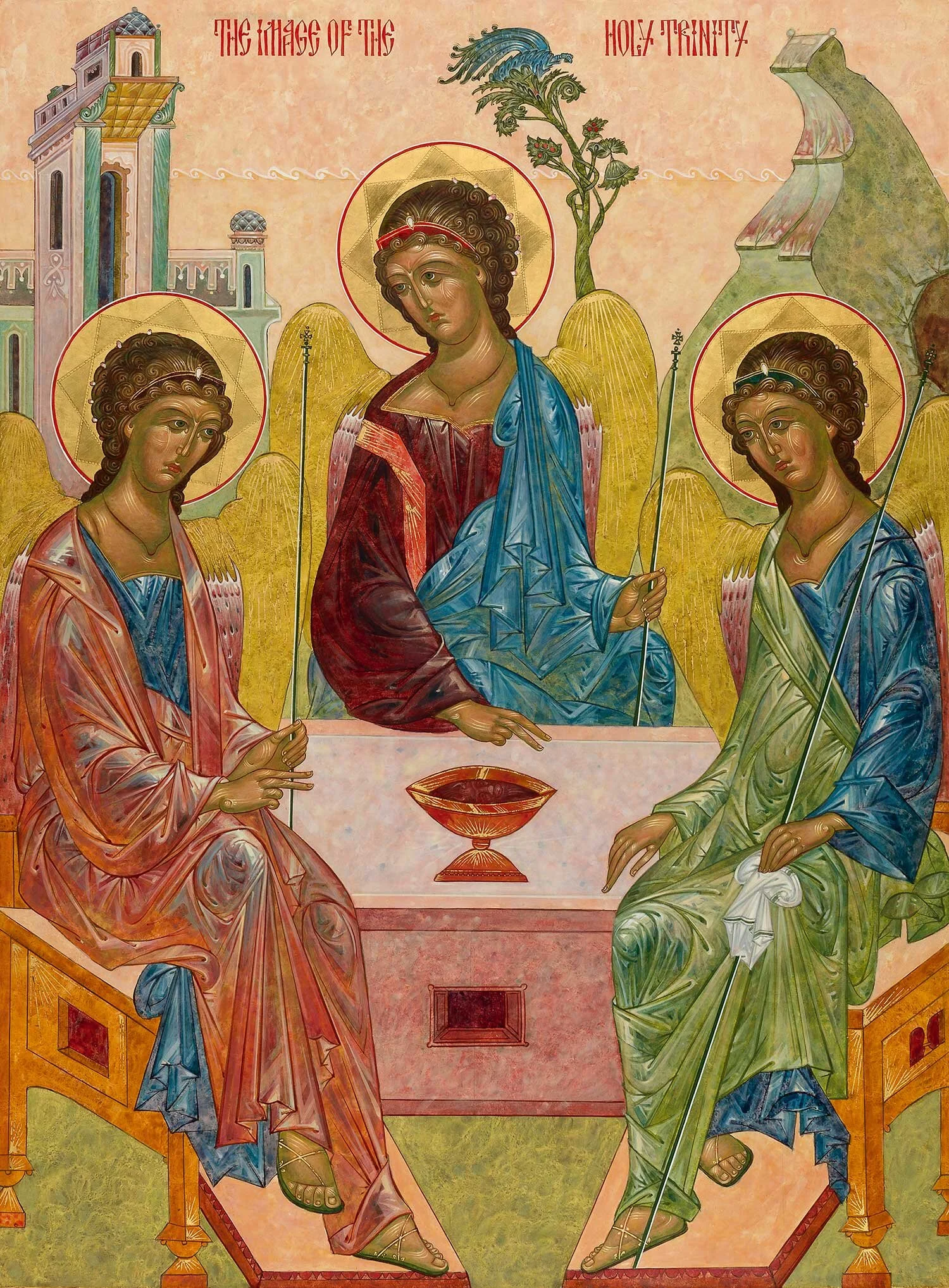Old Testament Trinity
Originally, this icon appeared in church narthexes as the “Hospitality of Abraham,” which depicted the scene of Abraham and Sarah serving a meal to three strangers who visited their encampment. Abraham quickly realized that these were special strangers, for the Genesis story recounts that God appeared to Abraham by the oak tree in Mamre—in other words, a theophany. Which can it be? Three men or singular God? The “classic” Christian answer is: both.
In the fifteenth century, Russian iconographer Saint Andrei Rublev stripped away the human figures of Abram and Sara usually portrayed in this icon and shifted the focus dramatically and exclusively to the three strangers (iconographically portrayed as angels whose halos have eight-pointed stars), seated at table together, sharing a cup of wine. In so doing, Rublev clearly indicated that this event was a revelation or theophany of the Holy Trinity. The Church eventually canonized Rublev a saint. Why? Because, among other reasons, he elevated iconography from a painted recording of historical events to a mystical encounter with the theology of the Christian faith. The image of the Holy Trinity, written here anew by the Prosopon School, is in the tradition of Rublev’s contemplation.
The geometric shape of perfection, the circle, is the foundation of this icon, reinforcing the concept of the Trinity: one God in three Persons. Three separate angels united indivisibly. At first glance, all three angels appear alike: halos, scepters, wings, sandals; the vibrant blue in their garments; the shared inscrutable expression on their faces; their graceful hands. Then, when one’s eyes are lifted, significant differences become apparent, indicating that the angels are distinct. Buildings tower behind one angel, a tree bends toward another, and mountains lean behind the third, yet all movement is aligned toward the cup, the image of sacrifice. The Trinity is one in essence, and delineating difference within the life of the Trinity is understood only through actions of God, not his essence; one might say that the buildings represent the Kingdom of the Heavenly Father. The tree symbolizes the new Tree of Life upon which God the Son was crucified. Mountains, in all iconography, symbolize the craggy progress of our life, step-by-step, stumbling upward toward the Kingdom, elevated and upheld through the work of the Holy Spirit.
If every visual element here symbolically depicts the life of the Trinity, it also, mystically, depicts a particular work of the Trinity. The cup in the center of the table holds within its red liquid the face of an ox, for it is not wine but blood, a sacrificial offering, and we see that what we are looking at is, in fact, not a portrait but an event. Here, the fate of humankind and the salvation of the world were decided in this Great Council of the Trinity, held before earth was created, when God said, “Let us make man in our image” (Genesis 1:26). In one timeless “instant,” God foresaw all the glorious potential and certain horror of a free humanity and decided, with the Son’s willing incarnation and self-sacrifice, to go ahead with it.
To say the icon depicts the life and work of the Trinity is also to say that the icon depicts the love of the Trinity. The three alertly bowed heads and the three hands gesturing toward the blood-filled cup beautifully convey a tri-fold “yes” to the Son’s obedient pouring of himself into the carnal vessel of a body. It is Christ that “sits” in the negative space “cup” formed by the position of the angels, for this angel wears Christ’s iconographic colors: blue outer robe and deep red inner robe. In Christ’s willing sacrifice, foretold and accepted before the foundation of the world, we encounter the Holy Trinity’s supreme action of love.
